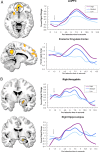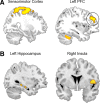Mental hoop diaries: emotional memories of a college basketball game in rival fans
- PMID: 20147540
- PMCID: PMC3319676
- DOI: 10.1523/JNEUROSCI.2481-09.2010
Mental hoop diaries: emotional memories of a college basketball game in rival fans
Abstract
The rivalry between the men's basketball teams of Duke University and the University of North Carolina-Chapel Hill (UNC) is one of the most storied traditions in college sports. A subculture of students at each university form social bonds with fellow fans, develop expertise in college basketball rules, team statistics, and individual players, and self-identify as a member of a fan group. The present study capitalized on the high personal investment of these fans and the strong affective tenor of a Duke-UNC basketball game to examine the neural correlates of emotional memory retrieval for a complex sporting event. Male fans watched a competitive, archived game in a social setting. During a subsequent functional magnetic resonance imaging session, participants viewed video clips depicting individual plays of the game that ended with the ball being released toward the basket. For each play, participants recalled whether or not the shot went into the basket. Hemodynamic signal changes time locked to correct memory decisions were analyzed as a function of emotional intensity and valence, according to the fan's perspective. Results showed intensity-modulated retrieval activity in midline cortical structures, sensorimotor cortex, the striatum, and the medial temporal lobe, including the amygdala. Positively valent memories specifically recruited processing in dorsal frontoparietal regions, and additional activity in the insula and medial temporal lobe for positively valent shots recalled with high confidence. This novel paradigm reveals how brain regions implicated in emotion, memory retrieval, visuomotor imagery, and social cognition contribute to the recollection of specific plays in the mind of a sports fan.
Figures



Similar articles
-
Component Neural Systems for the Creation of Emotional Memories during Free Viewing of a Complex, Real-World Event.Front Hum Neurosci. 2010 May 18;4:34. doi: 10.3389/fnhum.2010.00034. eCollection 2010. Front Hum Neurosci. 2010. PMID: 20508750 Free PMC article.
-
Remembering the big game: social identity and memory for media events.Memory. 2020 Jul;28(6):795-814. doi: 10.1080/09658211.2020.1784232. Epub 2020 Jun 26. Memory. 2020. PMID: 32588742
-
The spatiotemporal dynamics of autobiographical memory: neural correlates of recall, emotional intensity, and reliving.Cereb Cortex. 2008 Jan;18(1):217-29. doi: 10.1093/cercor/bhm048. Epub 2007 Jun 4. Cereb Cortex. 2008. PMID: 17548799
-
Neural Activations of Guided Imagery and Music in Negative Emotional Processing: A Functional MRI Study.J Music Ther. 2016 Fall;53(3):257-78. doi: 10.1093/jmt/thw007. Epub 2016 May 23. J Music Ther. 2016. PMID: 27221253
-
Retrieval of emotional memories.Psychol Bull. 2007 Sep;133(5):761-79. doi: 10.1037/0033-2909.133.5.761. Psychol Bull. 2007. PMID: 17723029 Free PMC article. Review.
Cited by
-
Retrieval, monitoring, and control processes: a 7 tesla FMRI approach to memory accuracy.Front Behav Neurosci. 2013 Apr 8;7:24. doi: 10.3389/fnbeh.2013.00024. eCollection 2013. Front Behav Neurosci. 2013. PMID: 23580061 Free PMC article.
-
Long-term, multi-event surprise correlates with enhanced autobiographical memory.Nat Hum Behav. 2023 Dec;7(12):2152-2168. doi: 10.1038/s41562-023-01631-8. Epub 2023 Jun 15. Nat Hum Behav. 2023. PMID: 37322234
-
Neural networks supporting autobiographical memory retrieval in posttraumatic stress disorder.Cogn Affect Behav Neurosci. 2013 Sep;13(3):554-66. doi: 10.3758/s13415-013-0157-7. Cogn Affect Behav Neurosci. 2013. PMID: 23483523 Free PMC article.
-
Wearable Cameras Are Useful Tools to Investigate and Remediate Autobiographical Memory Impairment: A Systematic PRISMA Review.Neuropsychol Rev. 2017 Mar;27(1):81-99. doi: 10.1007/s11065-016-9337-x. Epub 2017 Jan 9. Neuropsychol Rev. 2017. PMID: 28070792
-
Neural correlates of fanhood: the role of fan identity and team brand strength.Front Hum Neurosci. 2024 Jan 8;17:1235139. doi: 10.3389/fnhum.2023.1235139. eCollection 2023. Front Hum Neurosci. 2024. PMID: 38259339 Free PMC article.
References
-
- Addis DR, Schacter DL. Constructive episodic simulation: temporal distance and detail of past and future events modulate hippocampal engagement. Hippocampus. 2008;18:227–237. - PubMed
-
- Addis DR, Moscovitch M, Crawley AP, McAndrews MP. Recollective qualities modulate hippocampal activation during autobiographical memory retrieval. Hippocampus. 2004;14:752–762. - PubMed
-
- Aggleton JP, Vann SD, Oswald CJP, Good M. Identifying cortical inputs to the rat hippocampus that subserve allocentric spatial processes: a simple problem with a complex answer. Hippocampus. 2000;10:466–474. - PubMed
-
- Bernhardt PC, Dabbs JM, Jr, Fielden JA, Lutter CD. Testosterone changes during vicarious experiences of winning and losing among fans at sporting events. Physiol Behav. 1998;65:59–62. - PubMed
Publication types
MeSH terms
Grants and funding
LinkOut - more resources
Full Text Sources
Molecular Biology Databases
